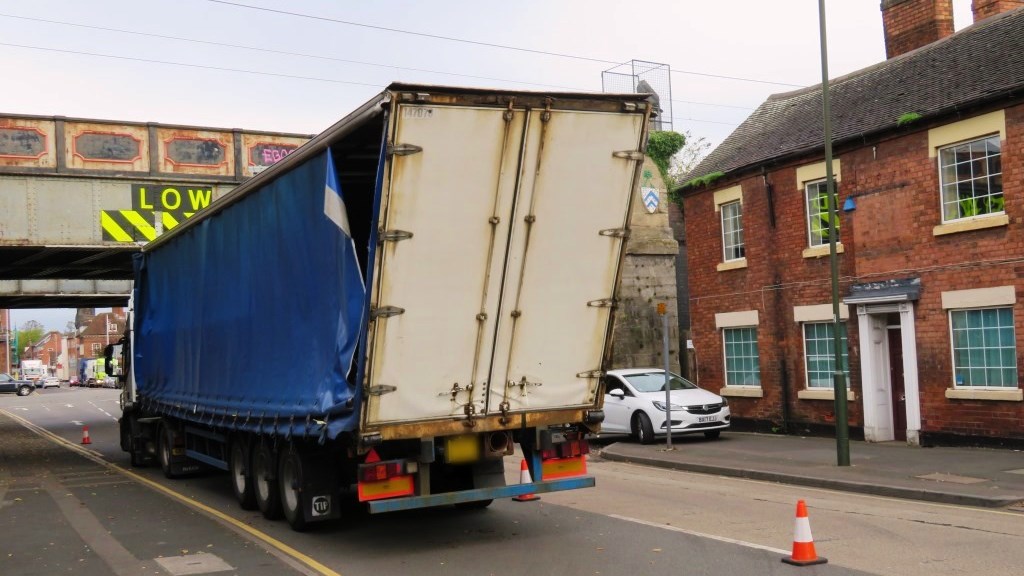Wednesday 16 Nov 2022
Lichfield railway bridge in national top ten most hit by HGV drivers
- Region & Route:
- North West & Central
- | North West & Central: Central
New figures show that for another year a railway bridge in Staffordshire is in the national top ten most bashed by HGV drivers.
Data released by Network Rail today (Wednesday 16 November) shows that St John Street bridge in Lichfield was hit 11 times between 2021/22, making it the ninth most struck in the country.
That is significantly down on previous years - in 2020/21 it was second most bashed at 18 times and in 2019/20 it was the third most struck in Britain with 23 incidents recorded.
In fact, St John Street became so notorious for damage that a Lichfield local set up its own Twitter account (@LichfieldBridge).
Despite the numbers going down in Lichfield, any bridge strike is one too many as the delays and damage caused are completely avoidable.
Bridge bashes cause major disruption to both train passengers and motorists and waste millions of pounds of taxpayers' money in repairs and compensation paid to train operators when their services are impacted.
Nationally, latest figures show that bridges were hit more than 1,800 times in 2021/22, costing Network Rail almost £12 million in delay and cancellation fees.
Martin Colmey, Network Rail’s Central route operations director, said: “There is no excuse for drivers to be hitting railway bridges. Everyone has a responsibility to know their vehicle’s restrictions and all of our bridges are very clearly marked to show what the clearance is. To hit a bridge with all this information available is unprofessional and negligent.
“I’m urging drivers to ‘Wise Up and Size Up’. Bridge strikes result in unnecessary delay and disruption to the road and rail networks and cost to the taxpayer. We take this issue very seriously and wherever possible we will seek to reclaim costs from the driver or company responsible.”
With more large vehicles on Britain's roads and the Black Friday and Christmas delivery rush fast approaching, Network Rail is once again urging lorry drivers and haulage operators to ‘Wise Up, Size Up’.
For 2022 a new animation has been released to make sure motorists know the height of their vehicles and choose suitable routes before they head out on journeys.
The retro-inspired cartoon centres on three high-sided vehicles navigating a low bridge in increasingly wacky ways, from pole-vaulting over it, to tunnelling underneath it.
The animation is designed to warn HGV drivers that life is not like the cartoons and to take a moment to think before taking a risk when approaching low bridges.
As part of this ongoing initiative, Network Rail has a team of bridge strike ‘champions’ covering each route across Britain, who raise awareness of the issue by visiting haulage companies and lead in managing bridge strike risk locally.
To find out more about how bridge strikes affect the rail network, click here.
To find out more about the ‘Wise Up, Size Up’ campaign, click here.
Notes to Editors
Network Rail works with a number of railway industry partners to tackle bridge strikes, including Highways England, the Driver and Vehicle Standards Agency (DVSA) and hauliers.
While incidents have reduced in recent years, numbers have steadily started to creep up again - coinciding with an estimated increase in traffic volume on Britain’s roads. Overall, provisional estimates show motor vehicles travelled 318.6 billion vehicle miles in Great Britain from April 2021 to March 2022 - a 29.7% increase compared to the year ending March 2021. Lorry traffic, in particular, increased by 10.1% to 17.8 billion vehicle miles.*
*Provisional road traffic estimates, Great Britain: April 2021 to March 2022, Department for Transport, click here.
Most struck railway bridges in Britain 2021/22:
- Stonea Road, Stonea, Cambridgeshire 33 strikes
- Lower Down’s Road, Wimbledon, London 18 strikes
- Harlaxton Road, Grantham, Lincolnshire 17 strikes
- Abbey Farm, Thetford, Norfolk 15 strikes
- Stuntney Road, Ely, Cambridgeshire 12 strikes
- Harefield Road, Brakespeare Road South, West Ruislip, London 12 strikes
- Station Road B4105, Berkswell, Solihull 12 strikes
- Station Road, Langley, Berkshire12 strikes
- St John’s Street, Lichfield, Staffordshire 11 strikes
- Coddenham Road, Needham Market, Suffolk 10 strikes
Bridge strikes reported across the railway network in the last five financial years:
Year 2017/18 – 2,039 strikes
Year 2018/19 – 1,926 strikes
Year 2019/20 – 1,720 strikes
Year 2020/21 – 1,624 strikes
Year 2021/22 – 1,833 strikes
Contact information
Passengers / community members
Network Rail national helpline
03457 11 41 41
Latest travel advice
Please visit National Rail Enquiries
Journalists
Network Rail press office - North West & Central Region
0330 854 0100
NWCmediarelations@networkrail.co.uk
About Network Rail
We own, operate and develop Britain's railway infrastructure; that's 20,000 miles of track, 30,000 bridges, tunnels and viaducts and the thousands of signals, level crossings and stations. We run 20 of the UK's largest stations while all the others, over 2,500, are run by the country's train operating companies.
Usually, there are almost five million journeys made in the UK and over 600 freight trains run on the network. People depend on Britain's railway for their daily commute, to visit friends and loved ones and to get them home safe every day. Our role is to deliver a safe and reliable railway, so we carefully manage and deliver thousands of projects every year that form part of the multi-billion pound Railway Upgrade Plan, to grow and expand the nation's railway network to respond to the tremendous growth and demand the railway has experienced - a doubling of passenger journeys over the past 20 years.
Follow us on Twitter: @networkrail
Visit our online newsroom: www.networkrailmediacentre.co.uk

